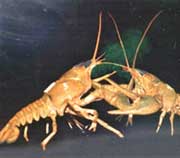Articles and reports from the Life Sciences and chemistry area deal with applied and basic research into modern biology, chemistry and human medicine.
Valuable information can be found on a range of life sciences fields including bacteriology, biochemistry, bionics, bioinformatics, biophysics, biotechnology, genetics, geobotany, human biology, marine biology, microbiology, molecular biology, cellular biology, zoology, bioinorganic chemistry, microchemistry and environmental chemistry.

Chemists put biological catalysts to work in clean industrial solvents.
In a move towards cleaner chemical processing, researchers in Spain and France have worked out how to use enzymes as catalysts using two ’green’ solvents: one to dissolve the enzyme, the other to dissolve the materials it transforms.
In some industrial processes chemists have replaced polluting organic solvents, such as chlorine and benzene, with supercritical carbon dioxide. This is the liquid

Research chemists have a found a class of synthetic molecules that could quite literally act as a key which could lock away sections of DNA into a closely wound coil preventing proteins from interacting with particular sections of DNA code. By locking up the DNA in this way scientists could stop particular sequences of DNA from activating biological changes that doctors or scientists would rather avoid, or wish to regulate closely.
Until now researchers trying to devise synthetic molecules t

Invading insect empire stretches 6,000 kilometres.
An invading empire has conquered Europe. One super-colony of South American ants, with millions of nests and billions of individuals, stretches 6,000 kilometres around the Mediterranean and Atlantic coasts, researchers have found.
Every ant in the colony treats every other as its nest-mate – even though they may be quite unrelated. The nests have buried their differences to create the largest cooperative unit ever discovered

Blood vessel prostheses work best when the biochemical and mechanical properties match reality as much as possible and when they are made of biodegradable material. To this end tissue technologists grow natural vascular wall cells, endothelial cells, in a biodegradable tube made of collagen. According to Professor István Vermes tissue technologists are overly concerned with developing stem cells, necessary to build blood vessels, and not enough with the development of the vascular skeleton or scaffo

In the city, frogs do not feel as comfortable as in the wild nature because of dirty water, a lack of food, and dangers at every turn. That is why the life of frogs in urban areas is shorter. However, they do not leave these habitats, but adapt to them. Apparently, there are two ways to adapt: either become more tolerant or increase the number of progeny.
Every spring from 1998 to 2001, Elena A. Severtseva and her colleagues from the Biological Faculty of the Moscow State University

A crayfish’s urine scares off its enemies.
A well-timed blast of urine is the key to winning a crayfish fight, say researchers. The chemical aggression intimidates opponents into backing down.
Ecologist Thomas Breithaupt injected freshwater crayfish with a dye that made their urine glow green. He and his colleague Petra Eger staged fights between blindfolded crayfish ( Astacus leptodactylus ), to replicate the animals’ nocturnal habits1.
The eventual